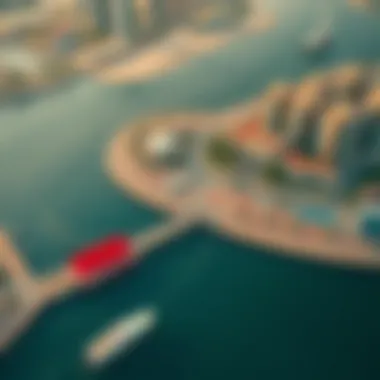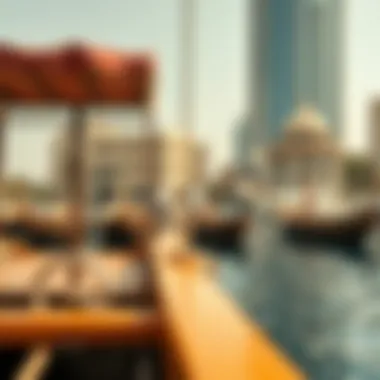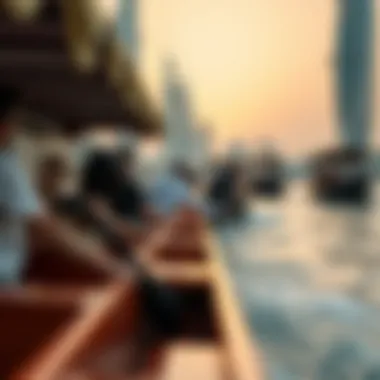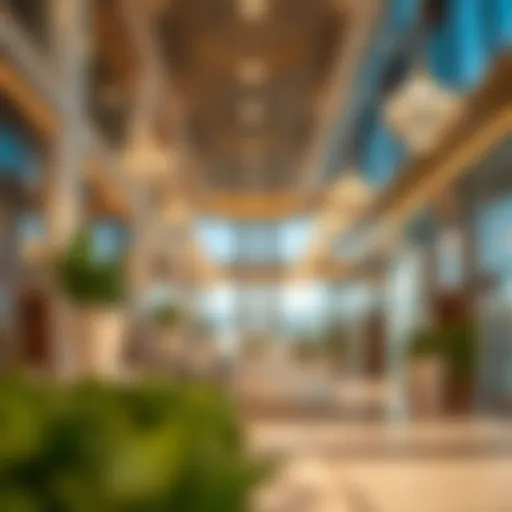Analyzing the Strategic Importance of Abra Dubai


Intro
Abra Dubai stands as a significant cultural and transport landmark within the bustling metropolis of Dubai. This traditional water taxi service reflects not only the city's vibrant history but also its modernization. With the shimmering waters of Dubai Creek as its backdrop, the Abra offers an unforgettable connection between the two bustling banks of the creek. Understanding its location and essence involves more than just geographical details; it's about how this waterway, steeped in tradition, has adapted to meet contemporary demands.
The importance of Abra Dubai transcends mere logistics. Historical roots dig deep into the fabric of everyday life in Dubai, making the service a vital thread in the urban tapestry. As one steps onto an Abra, it's not simply a ride but a journey through time and culture. This article aims to delve into the multifaceted aspects of Abra Dubai. From its geographical positioning to its role in facilitating urban mobility, the exploration will shed light on why this charming transport method holds such significance in the hearts of locals and visitors alike.
Geographically, Abra Dubai occupies a unique spot in city layout, bridging critical commercial and residential areas. The accessibility provided by this water transport not only eases the movement of residents but also enhances the experience of tourists who flock to witness the residential splendor of Dubai's historic quarter.
It is essential for potential investors and business owners to understand the broader context surrounding this waterfront service, as it affects not only the local community but also tourism and urban planning. With this introduction, we embark on a comprehensive analysis of the location of Abra Dubai, aiming to capture both its historical significance and its relevance in today’s rapidly evolving urban landscape.
Prolusion to Abra Dubai
Abra Dubai serves as a vital thread in the intricate fabric of Dubai's transportation landscape. This waterway transport service is not merely a mode of getting from point A to point B; it offers a peek into the city’s rich cultural backdrop and its rapid development over the years. Understanding Abra Dubai, its operations, and significance can provide investors, residents, and tourists with unique insights into the local dynamics.
In this segment, we will delve into two key areas that define Abra Dubai: its essence and historical significance. These insights will not only help contextualize the modern relevance of this service but also reflect how it has evolved and adapted to meet the changing demands of the bustling city.
What is Abra Dubai?
At its core, Abra Dubai refers to the traditional wooden boats that ply the waters of Dubai Creek, facilitating transport between the two banks of the waterway. These vessels are an integral part of the city's charm, showcasing a confluence of tradition and modernity. They significantly ease the movement of people and goods, catering to daily commuters and tourists alike.
These boats operate on a simple yet effective fare system, making them accessible to a wide range of individuals. Besides their functional role, Abros symbolize heritage—linking Dubai’s past to its visionary future. It’s a lively scene, watching these graceful boats ferry passengers while balancing efficiency with an authentic cultural experience.
Historical Significance
To grasp the full essence of Abra Dubai, one must appreciate its historical roots. The use of these wooden vessels dates back many centuries, rooting them firmly in the trading culture that characterized the region. Historically, they were essential in linking merchants and traders who relied on waterways for commerce and connectivity.
"Historically, the abras were crucial to the trade routes, serving not only London or Paris but contributing significantly to the economic landscape of Dubai."
As Dubai transformed from a modest fishing village into a global metropolis, the role of Abros shifted yet remained vital. They represent the resilience of a community that has adapted its practices while treasuring its heritage. Today, these boats are not just a means of transport but rather a living artifact of the Emirate’s rich history, symbolizing Dubai’s journey of development.
The Abra service continues to play a crucial role not just in transportation but also in fostering community ties across the city. As urbanization accelerates, the historical layers provided by these traditional boats remind us of the cultural narratives that continue to shape Dubai, keeping local traditions alive amidst modern developments.
Geographical Location of Abra Dubai
The geographical location of Abra Dubai holds immense significance in the wider context of Dubai's urban landscape. Placed strategically along the Dubai Creek, Abra is not merely a waterway but a pivotal artery that facilitates the movement across the bustling city. Understanding this location sheds light on its operational dynamics, accessibility, and the cultural heritage that surrounds it. As such, we see how its position boosts tourism and local economy while creating a congenial environment for residents.
Coordinates and Map Overview
Abra Dubai can be pinpointed at the coordinates 25.2655° N latitude and 55.3075° E longitude. This specific positioning places it right at the heart of Dubai Creek, enhancing connectivity to both the commercial and cultural districts. Navigating a map of Dubai reveals how the Abra stands as a key link between Deira and Bur Dubai, two of the oldest and most vibrant parts of the city. The visual aspect of a map highlights not just the pathway but also the entire vicinity that supports various activities, such as trading and local tourism.
A detailed map can be acquired through platforms such as Google Maps, which also offers satellite and street views for those wanting to understand the terrain better. The integrated waterway routes ensure that even visitors unacquainted with the city's layout can easily find their way, making it an invaluable asset for navigating Dubai.
Surrounding Landmarks
The surroundings of Abra Dubai are rich with landmarks that epitomize the essence of Dubai's history and modernity. Not far from the waterway, visitors can explore the historic Dubai Museum, located within the Al Fahidi Fort, which gives insights into the region's past. Another nearby attraction is the Gold Souk, a bustling marketplace famed for its gold jewelry, which attracts tourists and locals alike.


Furthermore, the proximity to Dubai Frame offers tourists a stunning view of both the old and new Dubai, making the area surrounding Abra not just a transit point but a hub of exploration.
Here’s a snapshot of some important landmarks near Abra Dubai:
- Dubai Museum: Offers a glimpse into the emirate's traditional lifestyle.
- Gold Souk: A vibrant market showcasing exquisite gold pieces.
- Dubai Frame: A modern marvel providing panoramic views of the city.
These landmarks further solidify Abra's role as a facilitator of connections not only geographically but also culturally and economically, enhancing its allure for expatriates and potential investors looking for opportunities in this dynamic city.
Accessibility and Transport Links
The accessibility of Abra Dubai plays a crucial role in its function as a transport service. It acts not just as a vessel for crossing the waterways, but also as a lifeline that connects various districts of Dubai. Understanding the transport links associated with Abra Dubai can offer significant benefits for both residents and visitors. It facilitates ease of movement, promotes economic growth, and integrates smoothly with various urban development projects. Good accessibility ensures that people can make the most of the city’s vibrant attractions.
Connecting Routes to Abra Dubai
The routes connecting to Abra Dubai are as diverse as the people who travel them. The service operates across several key locations in Dubai, bridging gaps between areas like Al-Souq and the bustling Dubai Mall, for instance.
- Dubai Creek: The primary route of Abra runs along Dubai Creek, where traditional structures and modern architecture coexist. This route allows passengers to witness the evolution of the city right from the water.
- Deira: A foundational hub for locals and tourists, Deira's market scene is easily accessible via Abra. Its winding waterways serve as a scenic alternative to the crowded streets.
- Bur Dubai: This area is culturally rich and integrates seamlessly with the Abra service. The routes support local commerce by providing quick access to shops and restaurants.
Notably, while tourists might think of Abra as merely a delightful ride, it also serves as a vital transport link for daily commuters. With multiple docking stations and frequent departures, the service provides reliability amidst the hustle and bustle of Dubai’s urban environment.
Public Transport Options
While Abra forms a quintessential part of aquatic transport, it doesn't operate in a vacuum. Instead, it forms a part of a broader public transport network within Dubai, designed to cater to the diverse needs of its residents and visitors alike.
- Metro Stations: Nearby metro stations, such as Al Ras and Burjuman, connect seamlessly with Abra docks, making transitions between land and water routes quick and efficient.
- Buses: The RTA bus service complements the Abra connections by providing routes that take passengers to lesser-known yet charming destinations within the city.
- Taxis and Ride-hailing Services: Easily available throughout Dubai, these services further enhance accessibility to Abra stops. It can be particularly beneficial for those who might be carrying luggage or wish to navigate directly through the city.
The existence of diverse public transport options not only elevates the convenience factor but also encourages the use of Abra as a sustainable alternative to conventional cars, thus promoting a reduction in urban congestion.
In summary, Abra Dubai's connectivity through various transport links is one of its standout features, presenting a blend of practicality and scenic experience that enhances its cultural and economic importance in the city.
Cultural Importance of Abra
The cultural significance of Abra Dubai is as deep as the waters it traverses. More than just a transport service, the Abra boats embody a rich tapestry of the Emirati culture and history. They are not merely vessels; they are connections between people, places, and stories. By understanding this cultural importance, one can appreciate the broader role Abra plays in the socio-economic matrix of Dubai.
Cultural Heritage
Abra Dubai serves as a living testament to the traditional maritime heritage of the region. The wooden boats, crafted with expertise passed down the generations, tell tales of resilience and adaptation. Historically, these boats were the lifeline for countless families, ferrying goods and passengers across Dubai Creek long before the advent of modern bridges and infrastructure. The craftsmanship alone stands as a reminder of the artisanal skills that existed well before the era of glitzy skyscrapers.
Visitors and residents alike enjoy the charm of these historical boats. The very design of an Abra, with their traditional shapes and rustic charm, evokes a sense of nostalgia. Furthermore, each ride on the Abra isn’t just a journey across the waterway; it’s a tiny pilgrimage through time. Travelers are offered a glimpse of the old Dubai, where trade flourished and markets bustled along the banks of the Creek.
The cultural festivals often held around the creek, featuring traditional music and dances, celebrate this rich heritage, inviting both locals and tourists to participate and appreciate the cultural tapestry. The narrative of Abra is thus intertwined with community gatherings, art displays, and historical reflections, making it a vibrant hub for cultural interaction.
Role in Local Communities
The role of Abra within local communities cannot be overstated. It acts as a bridge, linking neighborhoods and fostering interactions among diverse groups of people. On any given day, you can observe a mix of laborers, families, and tourists navigating the waterways, all together in this shared space. This mingling contributes to community cohesion and fosters a sense of belonging.
The affordability of riding an Abra ensures that it remains accessible to all strata of society. For many locals, it is a daily means of transport, integral to their routines. During the bustling hours, one can witness workers commuting to various markets, artisans bringing their goods, and families visiting relatives, each contributing to a social tapestry enriched by varied stories and backgrounds.


Moreover, the Abra serves as a significant economic driver for the communities surrounding Dubai Creek. Businesses like cafes, shops, and galleries thrive along the banks, fueled by the foot traffic generated by this transport service. When one factors in the tourists who flock to capture the spirit of Dubai, the importance of Abra transcends its functional role. It becomes clear that it stimulates economic opportunities, fosters small businesses, and enhances the quality of life for numerous residents.
“Abra is not just a ride; it’s an experience that encapsulates the essence of Dubai's soul.”
Through cultural events and community outreach, the Abra plays a pivotal role in promoting Emirati values and traditions. Its presence reminds the community of their collective history and strengthens the bond that unites them in the ever-evolving face of urban development. This blend of history, community interaction, and cultural appreciation underscores the full importance of Abra beyond mere transportation.
Economic Impact of Abra Dubai
The economic significance of Abra Dubai resonates deeply within the tapestry of Dubai's bustling trade and tourism landscape. This essential waterway transport system not only facilitates movement across the Dubai Creek but also plays a pivotal role in enhancing the local economy and encouraging a vibrant exchange of goods and services.
Tourism and Visitor Engagement
Abra Dubai serves as a magnet for tourists eager to experience a slice of traditional Dubai amidst its rapid modernization. Riding an abra is not just a means to cross the creek; it’s akin to embarking on a glimpse into the past, blending the old with the new. Visitors flock to the area not only to traverse the stunning waters but also to indulge in the rich culture and history surrounding the creek. Each ride provides a panoramic view of historical landmarks and modern architectural marvels, satisfying both the curiosity and the aesthetic sense of travelers.
The impact on tourism can be quantified in several ways:
- Increased Foot Traffic: Tourists using the abra service often lead to increased foot traffic in surrounding markets and attractions. The spice souk and gold souk, located nearby, see a notable uptick in visitors, appreciating the unique offerings of these traditional markets.
- Cultural Experiences: Visitors often engage in cultural tours that highlight traditional crafts, cuisine, and history, enhancing their understanding of Emirati culture.
- Revenue Generation: The fares collected from visitors, although modest, contribute cumulatively to the operational costs of the service, which supports maintenance and upgrades of the abrag and associated docking facilities.
Business Opportunities Along the Route
The economic landscape surrounding Abra Dubai is painted with diverse business opportunities that emerge from its strategic operations. As a vital connector of various sectors, it opens avenues for entrepreneurs keen on harnessing the potential of this unique transport system.
Potential Ventures:
- Food and Beverage Outlets: Cafes and restaurants situated near the docking areas can capitalize on the influx of hungry travelers. Tasty local dishes, quick bites, and thirst-quenching refreshments can carefully cater to the needs of those taking a breather after a ride.
- Retail Spaces: Vendors have the chance to sell handicrafts, souvenirs, and fashion items that resonate with both tourists and locals, turning foot traffic into a lucrative business.
- Guided Tours and Entertainment: Providing enhanced experiences, such as guided cultural tours that include abra rides combined with local storytelling can be profitable.
Considerations:
- Cost-effective Transport Solutions: Entrepreneurs must consider the overall cost implications of their ventures, ensuring affordability for both locals and tourists.
- Sustainability Practices: Given the increasing emphasis on environmental sustainability within Dubai, businesses should strive for eco-friendly practices in their operations to align with the city’s vision of a greener future.
The Abra isn’t just a transportation system; it’s a lifeline connecting various economic activities across the city, proving that sometimes the simplest designs foster the best value.
Environmental Considerations
When delving into the location and significance of Abra Dubai, it is paramount to include Environmental Considerations. This section addresses not only the sustainability practices that are emerging in this area but also the impacts that urban growth has on the environment. As a pivotal waterway in Dubai, Abra represents a link to both history and modernity, yet it sits at the crossroad of development and ecological conservation. Understanding these dynamics is crucial for investors, developers, and communities striving for balance between growth and preservation.
Sustainability Initiatives
Abra Dubai isn’t just a transportation route; it’s increasingly becoming a model for sustainability in urban planning. Several initiatives aim to minimize the environmental footprint of the Abra service and its surroundings. For instance, efforts have been made to incorporate solar panels on some of the vessels. This transition to renewable energy sources helps to reduce reliance on fossil fuels, which is a major goal for the UAE as a whole.
Furthermore, the local government is working on waste management strategies to keep the waterways clean. Trash traps and regular cleaning schedules are put in place to ensure that the Abra route stays as pristine as possible. These measures not only maintain aesthetic appeal but also protect local aquatic life.
The use of eco-friendly materials in the construction of docking stations and facilities also showcases a commitment to sustainable practices. Aligning with Dubai’s broader Green Strategy, these initiatives reflect a proactive approach to integrate environmentally sound practices into infrastructural growth.
- Benefits of Sustainability Initiatives:
- Reduces greenhouse gas emissions.
- Maintains aesthetic and ecological integrity of waterways.
- Preserves local biodiversity.


Impact of Urban Development
As Dubai continues to develop at a blistering pace, the impact of urban development on Abra Dubai and its environment cannot be overlooked. With an influx of tourists and residents, there is increased pressure on the infrastructure that supports Abra. New hotels and commercial spaces are popping up along the waterfront, raising concerns about how they affect water quality and local ecosystems.
Urban sprawl can lead to rising temperatures, which in turn affects water bodies. Changes in rainfall patterns can impact the balance of salinity in coastal waters. Studies indicate that careful urban planning can help mitigate these adverse effects. By integrating green spaces and natural buffers around Abra, the city can better protect its waterways.
"Sustainable urban development is not just a catchphrase; it is a necessity for the survival of our natural resources and the communities that rely on them."
Further, there’s been a noticeable shift towards creating mixed-use developments that support walkability and reduce car dependency. Such planning not only eases congestion but also minimizes pollution — a win-win situation.
Ultimately, as investors and developers consider the opportunity presented by Abra Dubai, factoring in these environmental aspects will be key. A focus on sustainability not only ensures regulatory compliance but also builds community trust, ensuring long-term viability of these developments.
Future Prospects for Abra Dubai
As the city of Dubai continues to evolve into a global hub of technology and tourism, the future prospects for Abra Dubai take center stage. With the increasing population and the consequential demand for efficient transport solutions, the focus on waterway transport reveals itself as pivotal for the city’s infrastructure. Abra Dubai stands not only as a cultural icon but also as an integral part of the everyday transit system. Its resilience and adaptability to future urban projects will deeply influence its relevance amidst the rapid urbanization.
Potential Developments
Looking ahead, there are several exciting avenues for development regarding Abra Dubai. Notably, the potential enhancements in service frequency can vastly improve user experience. Here are some potential developments:
- Increased Fleet Size: Expanding the number of Abras will reduce waiting times and accommodate a growing number of passengers.
- Enhanced Routes: Introducing new routes that connect to key business and entertainment districts, such as Dubai Mall or the Dubai Opera, would facilitate smoother access.
- Technological Integration: Functioning with mobile apps that offer real-time tracking of Abras could greatly enhance convenience for passengers, aligning with the tech-forward approach of Dubai.
- Eco-Friendly Initiatives: Considering greener alternatives for propulsion, such as solar-powered Abras, emphasizes sustainability while promoting the city’s environmental goals.
Understanding these developments showcases how Abra Dubai is poised to transform with the city it serves. These improvements not only enhance operational efficiency but also foster a more engaging experience for tourists and locals alike.
Integration with Smart Transportation
The integration of Abra Dubai with smart transportation systems represents a transformative leap into modern urban planning. By marrying traditional water transport with cutting-edge technology, the Abra system can become part of a cohesive, citywide transportation network.
- Connected Infrastructure: Linking the waterway routes with the existing metro and tram systems is paramount. Passengers could easily transfer from water to land, ensuring broader access to various parts of the city.
- Smart Ticketing Options: Implementing integrated ticketing systems that span across all modes of transport could streamline the travel processes, making it simpler and more appealing for commuters.
- Data-Driven Insights: Utilizing data analytics for route optimization based on real-time usage patterns would help in managing service levels efficiently. This ensures that the service meets the current mobility demands.
Overall, the fusion of Abra Dubai with smart initiatives not only enhances the operational framework but also places it in line with global transportation trends, making it more attractive to potential investors. The pathway forward is clear: maintaining its historical essence while innovating to meet modern demands will drive its success well into the future.
Key Insight: The future of Abra Dubai is fundamentally linked to both urban expansion and technological advancement. As these elements converge, Abra Dubai’s significance in the daily lives of its users will only grow, ensuring its status as an essential transit solution in Dubai.
Culmination
In summarizing the exploration of Abra Dubai, it’s clear that this waterway transport service is more than just a means to cross the Dubai Creek; it’s a vital part of the city’s vibrant social and economic tapestry. The insights gathered throughout the article highlight the multifaceted role of Abra in promoting connectivity and accessibility while also preserving historical and cultural narratives that define the region.
Key Elements
The importance of Abra Dubai can be dissected into various dimensions:
- Accessibility and Connectivity: With its strategic location, Abra not only facilitates daily commutes but also encourages tourism, giving visitors a unique vantage point of the city.
- Cultural Heritage: Emphasizing local traditions, the Abra service represents an enduring legacy that connects the past with the present, allowing both residents and tourists to experience this uniqueness.
- Economic Opportunities: Investors and entrepreneurs can seize the growing demand for tourist experiences surrounding the Abra, opening avenues for businesses alongside its route.
These elements underscore the necessity for ongoing assessment and planning to ensure Abra’s sustained relevance in Dubai’s evolving urban framework. The integration of modern technologies and sustainability initiatives can further enhance its operational capabilities without compromising its historical essence.
Key Takeaways
- Abra Dubai serves as a key transportation link within Dubai, playing a crucial role in the mobility of residents and visitors alike.
- The service provides a glimpse into the rich cultural history of the region, while actively contributing to the local economy through tourism and commerce.
- Urban planners and developers should consider the implications of Abra in shaping future infrastructural developments, focusing on balance between progress and preservation.
Final Thoughts
As we look to the future of Abra Dubai, maintaining the delicate equilibrium between tradition and modernity is paramount. The service not only meets the pragmatic needs of transportation but also enriches the lifestyle of those who engage with it. For investors and stakeholders, understanding the dynamics around Abra presents an opportunity to contribute towards sustainable urban growth and cultural preservation.
In this ever-competitive environment, recognizing Abra's potential as a linchpin for transport and tourism could lead to innovative solutions that enhance the overall experience for users and solidify its place in the heart of Dubai.







